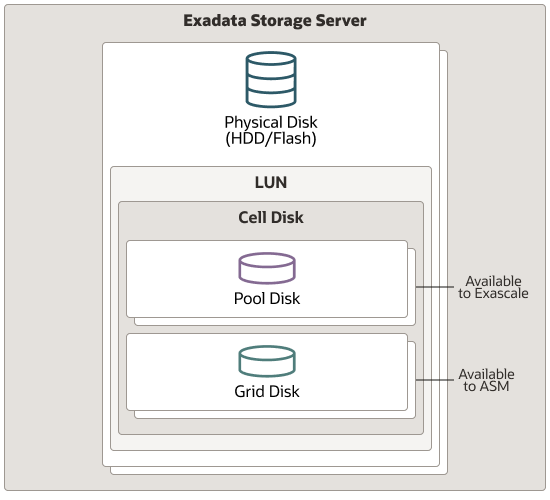1.3.2 Exadata Storage Management Overview
Each Exadata storage server contains the following hierarchy of data storage components:
-
Every Exadata storage server includes multiple physical disks, which can be hard disk drives (HDDs) and flash devices.
-
Each physical disk has a logical representation in the operating system (OS) known as a Logical Unit Number (LUN).
Typically, there is a one-to-one relationship between physical disks and LUNs on all Exadata storage server models. However, on Exadata X10M Extreme Flash (EF) storage servers only, each of the four 30.72 TB capacity-optimized flash devices is configured with 2 LUNs, resulting in 8 LUNs on each Exadata X10M EF storage server.
-
A cell disk reserves the space on a LUN for use by Exadata System Software. A LUN may contain only one cell disk.
Each cell disk is managed by Exadata System Software and can be further subdivided into multiple partitions known as grid disks and pool disks.
-
If the Exadata system is configured to use Oracle Automatic Storage Management (Oracle ASM) for storage management, then grid disks will be used.
A grid disk is an area of storage allocated from a cell disk that is directly exposed to Oracle ASM for use in an Oracle ASM disk group.
Each each cell disk can contain multiple grid disks, which enables multiple Oracle ASM clusters and multiple databases to share the same physical disk.
-
If the Exadata system is configured to use Oracle Exadata Exascale for storage management, then pool disks will be used.
A pool disk is an area of storage allocated from a cell disk that is directly exposed to Exascale for use in an Exascale storage pool.
While one cell disk can accommodate multiple Exascale pool disks, this is usually unnecessary because Exascale is inherently engineered to securely share storage pool resources amongst numerous tenants.
The following diagram summarizes the hierarchy of data storage components in each Exadata storage server.
Figure 1-4 Oracle Exadata Data Storage Components

Description of "Figure 1-4 Oracle Exadata Data Storage Components"
Oracle Automatic Storage Management (Oracle ASM) is the original cluster volume manager and file system used to manage Exadata storage resources. However, starting with Exadata System Software release 24.1, Oracle Exadata Exascale transforms Exadata storage management by decoupling Oracle Database and GI clusters from the underlying Exadata storage servers. Exascale software services manage pools of storage that span the fleet of Exadata storage servers and service all the database server clusters.
With the introduction of Exascale, you can choose from the following storage configuration options:
- For new system deployments (or redeployments of existing systems), you can choose Exascale instead of Oracle ASM. In this case, Exascale services are deployed across the system, and ASM instances are not required on the database servers.
- For new and existing deployments, you can continue using ASM without Exascale. In this case, you continue to use ASM instances on the database servers, and no Exascale services are required on the database and storage servers.
- For new and existing deployments, you can choose a hybrid configuration that uses Exascale and ASM. This option enables new and existing customers to implement Exascale while keeping selected databases on the time-tested storage management infrastructure provided by ASM.